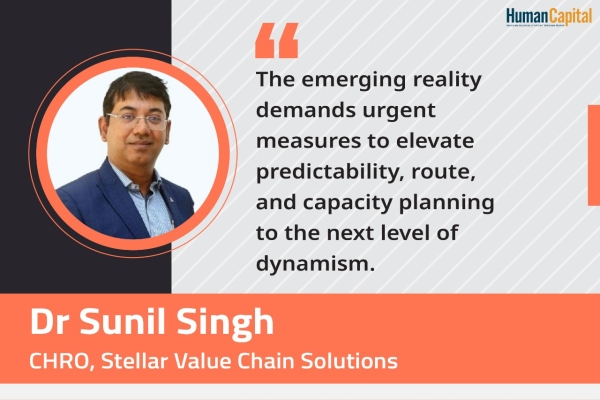Getting Ready For The Ride
Chek Lap Kok Airport in Hong Kong is one of those marvels of human ingenuity and perseverance that it makes even the most habitually indifferent to stop and wonder. Bridging the chasm between reality and science fiction, this mammoth endeavour to essentially “create land at sea”, has been the result of indomitable human will contending with an ambitious deadline. Meanwhile, HR organisations in global companies have a unique and an ambitious deadline to grapple with. In today’s environment, HR is under pressure to understand the workforce in greater depth in order to recruit, develop, and retain talent effectively. At the same time, the senior management is largely invested in having concise, up-to-date information about employees and related external factors that can be used to make business decisions and mobilize talent in line with the changing strategies. HR needs to constantly ask itself, “How can we help beat the competition?”
In Quotes “In today’s environment, HR is under pressure to understand the workforce in greater depth in order to recruit, develop, and retain talent effectively. At the same time, the senior management is largely invested in having concise, up-to-date information about employees and related external factors that can be used to make business decisions and mobilize talent in line with the changing strategies. HR needs to constantly ask itself, “How can we help beat the competition?” “
The unlikely analogy with the gargantuan Chek Lap Kok still begs an explanation, though. For the uninitiated, Hong Kong’s airport has been built at sea on reclaimed land. The italicized words emphasize the almost ‘meeting-of-the-elements’ romanticism that this structure emulates. Islands were levelled, the sea was forced back, and typhoons were braved.
The learning here is not steeped in the glory of the conquest, but stems from the practicalities that made it possible. The specialised talent, the design expertise, cutting‑edge technology and machines; these and their kind were ‘external agencies’, the equivalent of which we need in the HR ecosystem if companies are to achieve their own goal of strengthening organisational performance and improving employee experience and ROI. Automation, the need for digital skills, demographic shifts and globalization are upending labour supply and demand. A successful HR transformation today is much akin to “creating land at sea”, one that can be achieved via Advanced Analytics. With the underlying theme of ‘transformation’, this makes for a case for HR organisations to find better ways to leverage advanced analytics, and use it to build an agile, responsive and focused workforce.
Analytics, supported by digital technology, is the bedrock that can help enable professionals to make better, quicker and more informed decisions that are aligned to the organisation’s strategy. Human capital analytics delivers critical insights about the organisation’s people, their preferences, what makes them contribute towards the success of the business. Analytics presents an opportunity for HR to develop innovative solutions across all HR process areas to help answer questions like: How can we improve the likelihood of the acceptance of job offers made to candidates? What is the ideal blend of training courses to maximize ROI? What are the critical drivers which we could focus on to drive employee engagement AND retention?
Next generation business intelligence tools enable automated real-time reporting with both descriptive and predictive analytics, delivered through cloud platforms. The costs to deliver analytics is significantly lower than what was feasible in the past. This is an important competitive advantage for businesses globally, and has changed the role that HR has in delivering the business strategy.
IN A BOX
The Art of the Possible
Real-life examples of HR analytics algorithms that can be operationalised include the following
|
Recruitment Funnel Analytics
|
Learning Effectiveness
|
|
High Performance Profiling
|
Employee Attrition Prediction
|
Building a Analytics-Driven HR organisation
First, conduct a strategy assessment and identify areas that stand to benefit the most from application of analytics to the HR function. Understanding the link between talent decisions and business outcomes is key to build a business case for HR Analytics. Once the assessment exercise is complete, the outcome is usually a set of use cases that are prioritized based on their importance to the business and complexity of deployment. This leads to a roadmap with a defined set of actions for near, mid, and long-term consideration:
1. Data Requirements: Determine the type of traditional and non-traditional data sets required, and the best methods to source, integrate and store such information with minimal manual effort.
2. Think Big, Start Small, Scale Fast: A critical step in building a business case for analytics is a targeted proof of concept exercise to demonstrate how HR analytics can deliver value to the business and how HR can adopt analytics at scale. Two critical outcomes to strive for from such an exercise would be- quantification of business value and functional excellence.
3. Invest in analytics capabilities for the HR workforce: To create an analytics culture within the organisation and achieve sustained growth along the analytics journey, it is critical to formalize an approach towards building and improving analytics capabilities among employees of the HR organisation.
Looking ahead
Overall, analytics technologies hold tremendous potential for HR—but many organisations are yet to leverage the advantages of such technologies. According to researchers, only 13% of HR officers say that they have the analytics and tools needed to drive their functions. In a recent Oracle/Human Capital Institute survey, the executives were asked which key metrics would be positively affected by having more robust talent insights, and, 58% said profitability and 60% said revenue per employee. With analytics, HR can strengthen organisational performance and plan proactively rather than operate reactively. And perhaps most importantly, it can provide practical answers to the questions being asked by the business, and strengthen its role as a trusted advisor on how to best manage and deploy talent in alignment with organizational objectives.
In Quotes “With analytics, HR can strengthen organisational performance and plan proactively rather than operate reactively. And perhaps most importantly, it can provide practical answers to the questions being asked by the business, and strengthen its role as a trusted advisor on how to best manage and deploy talent in alignment with organisational objectives.”
References:
1. https://www.accenture.com/in-en/service-fei-digital-hr-transformation-inform-analytics
2. https://www.accenture.com/in-en/~/media/Accenture/Conversion-Assets/DotCom/Documents/Global/PDF/Digital_1/Accenture-Oracle-HCM-eBook-Future-of-HR-Five-Technology-Imperatives.pdf
3. Accenture - Talent and HR Analytics
Do you look forward to permanently working from home after the pandemic subsides?
Trending
-
SBI General Insurance Launches Digital Health Campaign
-
CredR Rolls Out 'Life Happens' Leave For Its Employees
-
Meesho Announces 30-Week Gender-Neutral Parental Leave Policy
-
Microsoft Unveils Tech Resilience Curriculum To Foster An Inclusive Future
-
60% Indian Professionals Looking For Job Change Due To COVID: Survey
-
SpringPeople And Siemens Collaborate For Digital Transformation Push
-
86% Professionals Believe Hybrid Work Is Essential For Work Life Balance: Report
-
Almost 1 In Every 3 People's Personal Life Affected Due To Work Stress
-
Meesho Rolls Out Reset And Recharge Policy For Employees
-
80% Of Talent Leaders & Academics Say Pandemic Changed Skill Needs For Youth: Report
-
Hero Electric Rolls Out 'Hero Care' Program For Employees
-
Human Capital In Collaboration With ASSOCHAM Hosts Virtual Conference
-
IKEA India, Tata STRIVE Collaborate To Create Employability And Entrepreneurship Opportunities
-
SAP India, Microsoft Launch Tech Skilling Program for Young Women
-
DXC Technology, NASSCOM Collaborate For Employability Skills Program
-
Lenskart To Hire Over 2000 Employees Across India By 2022
-
Mindtree Launches Learn-and-Earn Program
-
Tata AIA Extends 'Raksha Ka Teeka' To Its Employees
-
Swadesh Behera Is The New CPO Of Titan
-
NetConnect Global Plans To Recruit 5000 Tech Professionals In India
-
Hubhopper Plans To Hire 60% Of Indian Podcasters By 2022
-
Corporate India Needs More Women In Leadership Roles: Report
-
Aon to Invest $30 Million and Create 10,000 Apprenticeships by 2030
-
Tech Mahindra Launches ‘Gift a Career’ Initiative for Upskilling of Youth
-
40% Women Prefer Flexible Working Options in Post-COVID World: Survey
-
3 out of 4 companies believe they can effectively hire employees virtually: Report
-
Vodafone , CGI and NASSCOM Foundation launch digital skills platform
-
Odisha: Bank, postal employees to deliver cash for elderly, differently-abled persons
-
Skill India launches AI-based digital platform for "Skilled Workforce"
-
Hiring activity declines 6.73% in first quarter: Survey
-
70% startups impacted by COVID-19 pandemic
-
Bajaj Allianz Life ropes in Santanu Banerjee as CHRO
-
Over 70 Percent MSMEs look at cutting jobs to sustain businesses
-
93 Per Cent employees stressed about returning to office post-lockdown
-
Johnson & Johnson India announces family benefits for same gender partners
-
Indian firms turning friendly towards working mothers
-
Welspun India names Rajendra Mehta as new CHRO
-
Wipro partners with NASSCOM to launch Future Skills platform



Human Capital is niche media organisation for HR and Corporate. Our aim is to create an outstanding user experience for all our clients, readers, employers and employees through inspiring, industry-leading content pieces in the form of case studies, analysis, expert reports, authored articles and blogs. We cover topics such as talent acquisition, learning and development, diversity and inclusion, leadership, compensation, recruitment and many more.
Subscribe Now












































Comment